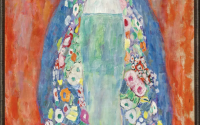Newsmakers: Tampa Museum of Art’s Executive Director on Preparing for Hurricane Milton and Sheltering at the Institution
Editor’s Note: This story is part of Newsmakers, a new ARTnews series where we interview the movers and shakers who are making change in the art world.
As Hurricane Milton landed last night as a Category 3 hurricane, Tampa Museum of Art executive director Michael Tomor was prepared to be at the institution for at least three or four days.
“When I moved down here, which was this morning, I have enough food and clothing and I have army cots for the next three to four days, because I actually have no idea when I can go home,” Tomor told ARTnews. “You just make it happen.”
Tomor’s choice to be at the museum was due to his home being located in a red Zone A, which the Florida Division of Emergency Management defines as “most vulnerable and the most likely to evacuate first.” And while the museum is also in a red Zone A, Tomor said he needed to be “in a position of decision making” in case anything happened, and that he felt very safe inside.
“Our facility has been designed to withstand a direct hit from a category three on the second floor, we just completed a 25,000 square-foot renovation, which brought up to code the first floor for a direct hit at a Category Four,” Tomor told ARTnews. “So we’re ready.”
Annual preparation and planning
At the start of each hurricane season in May, the Tampa Museum of Art prepares by doing a full team review with its manager of security, manager of collections, and facilities manager. “We walk through all of the different scenarios of what has to happen,” Tomor said. “For flooding, it’s for temperature, it’s for humidity; all of those are reviewed in great detail in advance, and then we act on them.”
This review was also done recently after Hurricane Helene, which resulted in damage experienced by local collectors and the institution advising them in response. “That was a huge wake up call, I think, for everybody, and got them really ready for what’s happening right now,” he said. “That’s still our responsibility to make sure that they know where their art should go and how to conserve it accordingly.”
In regards to concerns about storm surges and the risk of flooding from heavy rain, Tomor said that part of the renovation that was completed in 2023 also tested for leakage coming into the facility. “And we have none,” Tomor told ARTnews the evening of October 9. “We’re not expecting any tonight or tomorrow, and even if we were, it wouldn’t be something that we haven’t prepared for.”
Safety in the red zone
Tomor isn’t alone in his choice to stay at the Tampa Museum of Art, a decision which requires a signed waiver that states a voluntary choice to remain in spite of a government-mandated evacuation order. The institution’s security manager, his wife, three children, and mother-in-law also stayed at the museum due to the vulnerable location of their home; along with two security guards, and Tomor’s husband.
In addition to the museum’s emergency staffing, preparations for Hurricane Milton included a full generator for its chiller plant, a type of centralized cooling system for buildings that would help maintain industry standards for temperature control and relative humidity.
“Should we lose power—and I think that there’s 100% certainty that we will at one point tonight, maybe early tomorrow morning—the generators will kick on, and the entire physical plant, or the generators have been designed to take care of making sure that the HVAC and the temperature control system works for the areas that have art on the walls and storage,” Tomor said, noting that if the generators did kick in, the HVAC system was only programmed for the building’s first and second floors, and not the office complex on the third floor where he was currently hunkering down. “It’s all been programmed in the system to handle this very situation.”
Communication with lenders and community organizations
In terms of insurance, the Tampa Museum of Art has a “huge liability” for its permanent collection, but also for works on loan. “Our first and and most important responsibility is to make sure that the lenders to our institution know what our work plans are,” Tomor said.
In addition to telling lenders the museum’s plans for their collections and how they will be safeguarded, the institution’s collection manager identified which loaned works and items from the permanent collection needed to be moved to a safe location. “My collections manager already took care of this,” Tomor said, noting the lenders had been informed the morning of October 7, two days prior.
Finally, the museum joined an email chain with several other cultural institutions in the area, including Zoo Tampa, the Florida Aquarium, the Children’s Museum, and the Tampa Bay History Center to determine as a group when they would close and how to inform the public. Tomor was also in contact with the Salvador Dali Museum and the James Museum of Western & Wildlife Art in St. Petersburg.
“We want to make sure that our messaging is not confusing to the public, more than it is about panicking,” Tomor said. “I think that we just want to make sure that the community understands that we’re all in step. We all believe that this is the right thing to do.”
Compounded by the impact of Hurricane Helene
While disaster planning is part of the job for many directors at Florida cultural institutions, it’s worth noting that Tomor is also juggling the devastating impact of storm surges after Hurricane Helene, including the personal loss of one of his cars and damage to his own property.
“Many, many of my staff, people have no homes after Hurricane Helene, which was only 10 days ago; left them with nothing,” Tomor said. “On a human resources level, on an HR level, it’s also very complicated.”
The Salvador Dali Museum in nearby St. Petersburg, Florida, was also designed to withstand a Category 5 hurricane with third floor galleries located well above flood level. Tomor said museum director Dr. Hank Hine told him about feeding two or three of his staff members out of the institution’s restaurant after the loss of their homes. “They have no place to go,” he said.
On the evening of October 9, Hurricane Milton made landfall at Siesta Key, about 70 miles south of Tampa, knocking out power to to more than 3 million customers and whipping up 150 tornadoes, according to the Associated Press.
“Fingers crossed for all of us in the zone,” Hine emailed ARTnews the evening of October 9. “A few hours will determine the outcome. Winds are fierce here.”



